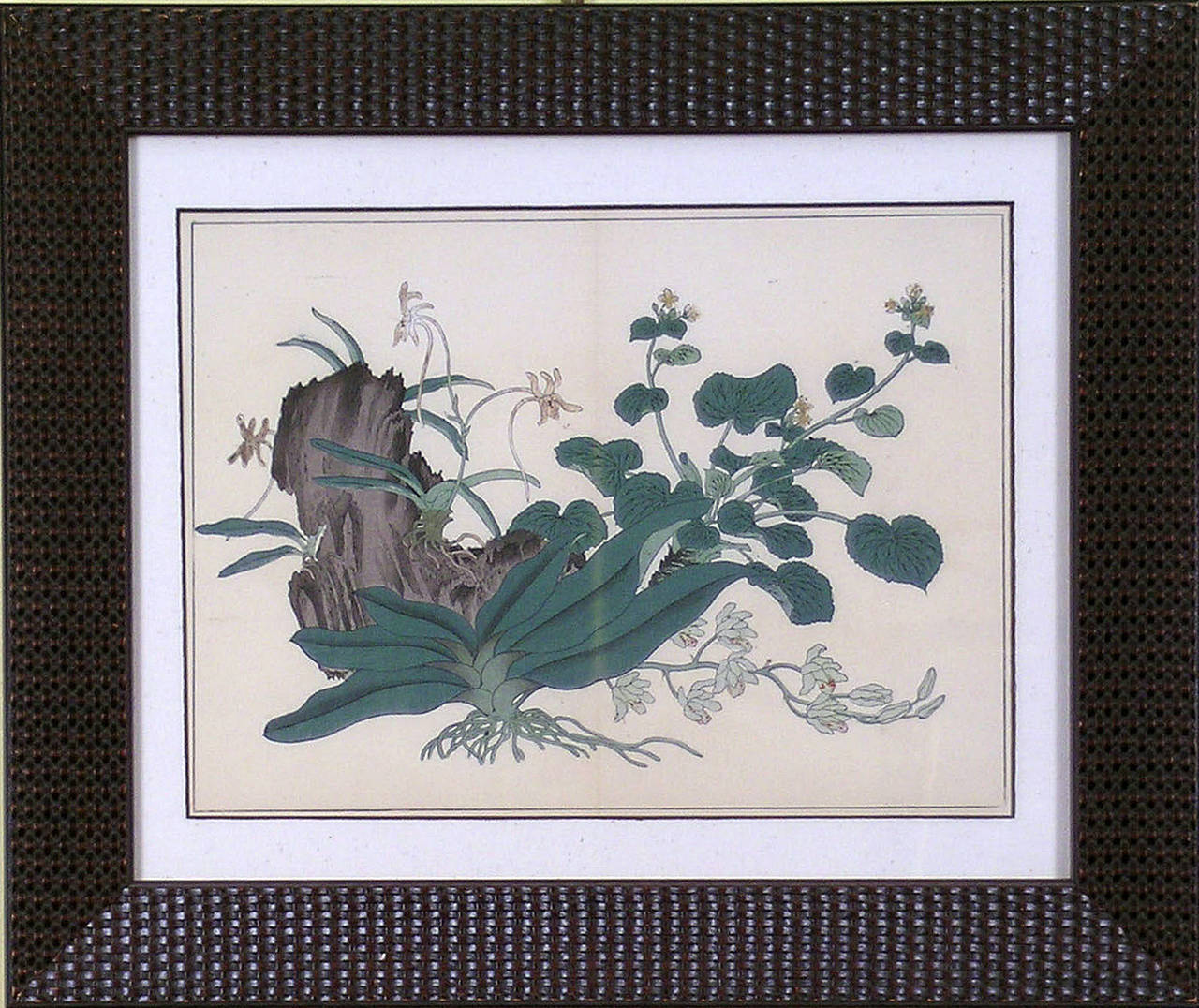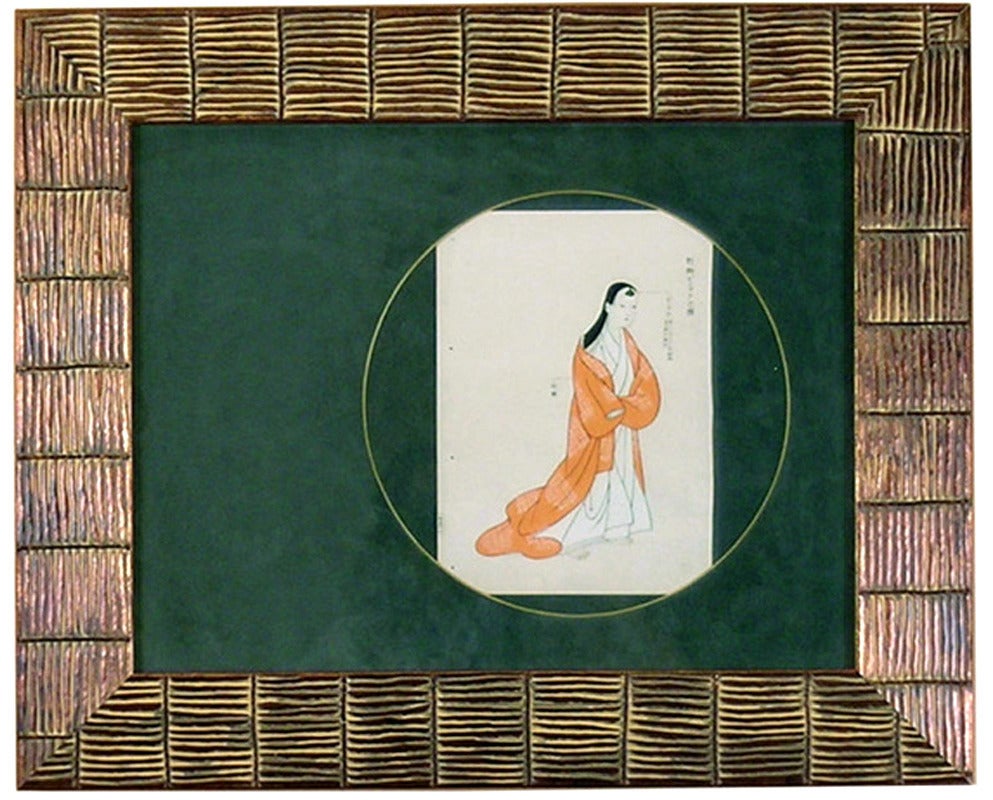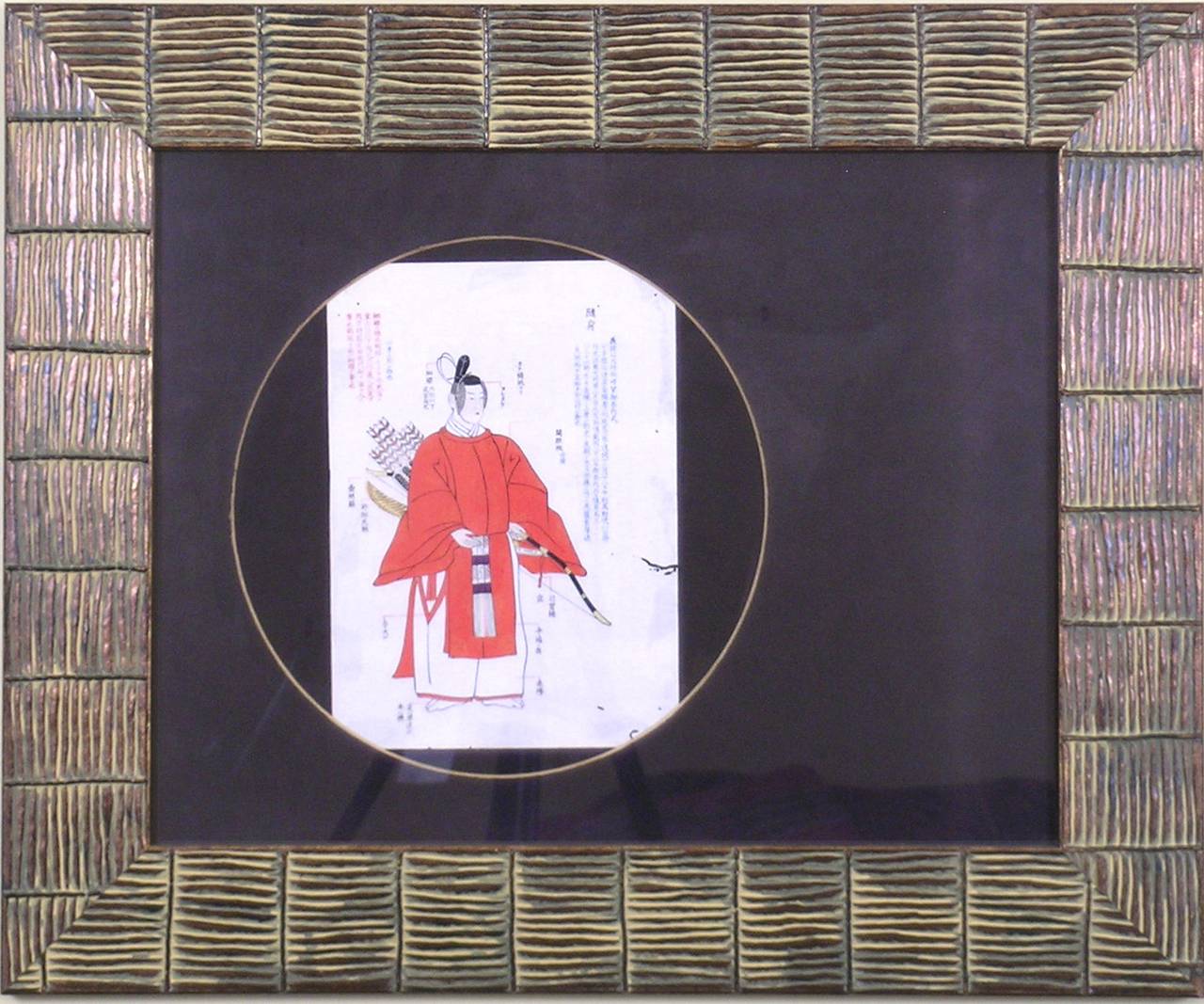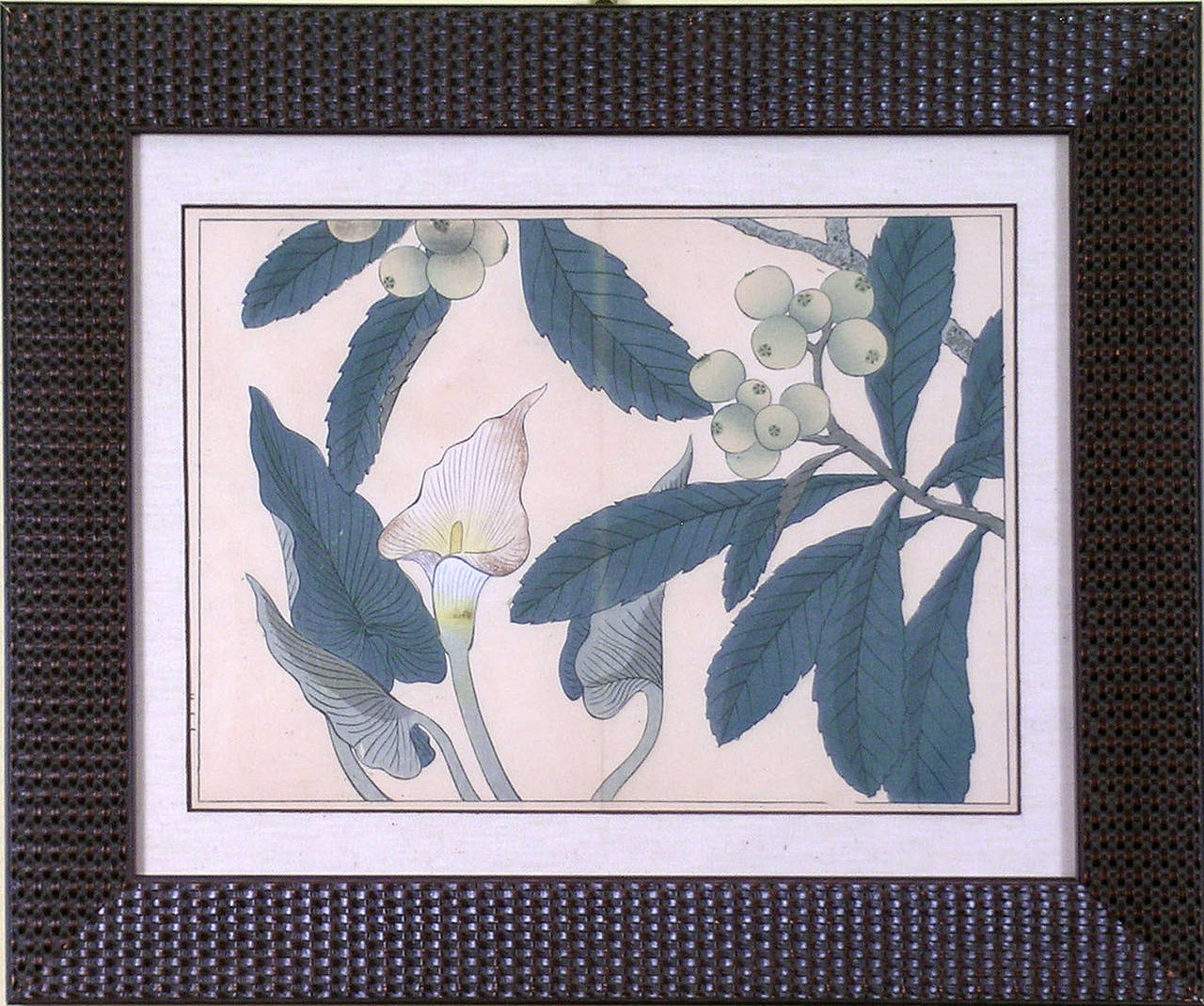Want more images or videos?
Request additional images or videos from the seller
1 of 3
UnknownIkebana - Carnations and Astilbeca 1895
ca 1895
About the Item
Ikebana
Japanese Woodblocks.
Meiji Period. Circa 1895.
A disciplined art form, Ikebana seeks to bring nature and man together. The emphasis is on form and simplicity of design. Although minimalistic, form is of the utmost importance. There is also a spiritual side to Ikebana with silence being a must throughout its practice.
The enthusiasm for nature prints has spanned the centuries. By the mid-nineteenth century these works, illustrating varieties of flowers in naturalistic styles, had reached a peak of perfection. Each artistic form in traditional printing sought to enhance the beauty of botany. In the woodblock style, as it true for engravings and lithographs, it is imperative that the carving of each block be exacting as they must create an image true to that seen in nature.
Woodblock printing flowered in the Edo Period in Japan, mid to late 19th century, and is still considered an art form of great precision and beauty. This style captures both the vitality and life inherent to the flower. Following the artist’s sketch, an image is carved into a block of wood to be transferred to paper in the same manner in which a painter applies his art to a canvas. Black inks form the outline of the flower and color inks are applied following nature’s guide. The woodblock is then pressed to hand-made screened paper which is then hung to dry. This lengthy process of composing a single image can take weeks. These images reflect a quality similar to watercolor and graphite resulting in a stunning and life-like portrayal.
- Creation Year:ca 1895
- Dimensions:Height: 9.5 in (24.13 cm)Width: 11.5 in (29.21 cm)
- Medium:
- Movement & Style:
- Period:
- Condition:Very good condition with minor stain on seam. Crisp image with beautiful original color. Framed to museum specifications using archival matting, backing, hinging. Suede mat. Glazed with ultra-violet filtering Plexiglas.
- Gallery Location:Florham Park, NJ
- Reference Number:
About the Seller
5.0
Gold Seller
These expertly vetted sellers are highly rated and consistently exceed customer expectations.
1stDibs seller since 2014
161 sales on 1stDibs
Typical response time: 3 hours
- ShippingRetrieving quote...Ships From: Florham Park, NJ
- Return PolicyA return for this item may be initiated within 1 day of delivery.
More From This SellerView All
- OrchidBy Kono BaireiLocated in Florham Park, NJKono Bairei (1844 – 1895) One Hundred Flowering Plants. Japan, 1901. (Posthumous.) Woodblock Print. 15 x 11.unframed. Okura Magobei, Publisher. The enthusiasm for nature prints transcends the centuries. “One Hundred Flowering Plants” is a mid-nineteenth century work illustrating varieties of flowers and plants in naturalistic styles. Traditional woodblock printing enhances the beauty of each work. The artist must carve different woodblocks for every color he wishes to transfer to paper. In this style of printing it is imperative that the register of each woodblock be exact as they must match perfectly to create an image without blurring. In addition to his illustrated flower books...Category
Early 1900s Academic Prints and Multiples
MaterialsWoodcut
- Kimono: Woman in OrangeBy Matsui YuokuLocated in Florham Park, NJREISHIN GACHO (Album of Beautiful Designs) Japanese Kimono Designs Matsui Yuoku, Painter Japan, 1900 (Meiji 33) Honda Ichijirou, Publisher Woodblock Prints Celebrated as mu...Category
Early 1900s Academic Prints and Multiples
MaterialsWoodcut
- Kimono: Man in RedBy Matsui YuokuLocated in Florham Park, NJREISHIN GACHO (Album of Beautiful Designs) Japanese Kimono Designs Matsui Yuoku, Painter Japan, 1900 (Meiji 33) Honda Ichijirou, Publisher Woodblock P...Category
Early 1900s Academic Prints and Multiples
MaterialsWoodcut
- BambooBy Kono BaireiLocated in Florham Park, NJKono Bairei (1844 – 1895) One Hundred Flowering Plants. Japan, 1901. (Posthumous.) Woodblock Print. 15 x 11. Okura Magobei, Publisher. The enthusiasm for nature prints transcends the centuries. “One Hundred Flowering Plants” is a mid-nineteenth century work illustrating varieties of flowers and plants in naturalistic styles. Traditional woodblock printing enhances the beauty of each work. The artist must carve different woodblocks for every color he wishes to transfer to paper. In this style of printing it is imperative that the register of each woodblock be exact as they must match perfectly to create an image without blurring. In addition to his illustrated flower books...Category
Early 1900s Academic Prints and Multiples
MaterialsWoodcut
- Cala LilyBy Kono BaireiLocated in Florham Park, NJKono Bairei (1844 – 1895) One Hundred Flowering Plants. Japan, 1901. (Posthumous.) Woodblock Print. 15 x 11. Okura Magobei, Publisher. The enthusiasm for nature prints transcends the centuries. “One Hundred Flowering Plants” is a mid-nineteenth century work illustrating varieties of flowers and plants in naturalistic styles. Traditional woodblock printing enhances the beauty of each work. The artist must carve different woodblocks for every color he wishes to transfer to paper. In this style of printing it is imperative that the register of each woodblock be exact as they must match perfectly to create an image without blurring. In addition to his illustrated flower books...Category
Early 1900s Academic Prints and Multiples
MaterialsWoodcut
- Rosa (Roses)By John ParkinsonLocated in Florham Park, NJJOHN PARKINSON (1567-1650). Paradisi in Sole Paradisus Terrestris. Published by Thrale. London, 1629. Woodcuts by Christopher Switzer. Later hand color. 110 woodcuts. "...a Garden of all sorts of pleasant flowers which our English are will permit to be noursed up...". Parkinson's work is among the most famous English gardening books...Category
18th Century and Earlier Academic Prints and Multiples
MaterialsWoodcut
You May Also Like
- Louis I of France as a Roman Emperor, in profile to the rightBy Christoffel JegherLocated in Fairlawn, OHLouis I of France as a Roman Emperor, in profile to the right Chiaroscuro woodcut, 1631-1633 Unsigned (as usual) After a drawing by Hubert Goltzius (1526-1583)...Category
17th Century Academic Portrait Prints
MaterialsABS, Woodcut
- Greek Architecture Blueprint of Ancient Amphitheatre Cyanotype Print, WatercolorBy Kind of CyanLocated in Barcelona, ESThis is an exclusive handprinted limited edition cyanotype. Details: + Title: Ancient Roman Amphitheater + Year: 2022 + Edition Size: 50 + Stamped and Certificate of Authenticity provided + Measurements : 70x100 cm (28x 40 in.), a standard frame size + All cyanotype prints...Category
2010s Academic Still-life Photography
MaterialsPhotographic Film, Woodcut, Emulsion, Watercolor, C Print, Color, Lithog...
- Tetbury Church - Signed Lithograph, Royal Art, Royal Heritage, Cotswolds, BritishLocated in Knowle Lane, CranleighTetbury Church by His Majesty King Charles III - Hand Signed Limited Edition Lithograph. Belgravia Gallery has been honoured to be associated with ...Category
1990s Academic Landscape Prints
MaterialsLithograph
- Overlooking Wadi, Saudi Arabia - Signed Lithograph, Royal Art, Mountains, AsirLocated in Knowle Lane, CranleighOverlooking Wadi, Asir Province, Kingdom Of Saudi Arabia by His Majesty King Charles III, (created when he was HRH The Prince of Wales) - ...Category
Early 2000s Academic Landscape Prints
MaterialsLithograph
- Hong Kong from HMY Britannia - Signed Lithograph, Royal Art, Union Jack,Located in Knowle Lane, CranleighHong Kong From HMY Britannia by HM King Charles III - Hand Signed Limited Edition Lithograph. Belgravia Gallery has been honoured to be associated ...Category
Early 2000s Academic Landscape Prints
MaterialsLithograph
- Glengairn, Aberdeenshire - Signed Lithograph, Royal Art, Scotland, BritishLocated in Knowle Lane, CranleighGlengairn, Aberdeenshire, January by His Majesty King Charles III - Hand Signed Limited Edition Lithograph. Belgravia Gallery has been ...Category
Early 2000s Academic Landscape Prints
MaterialsLithograph
Recently Viewed
View AllMore Ways To Browse
Antique Flower Prints Art Prints
Wood Block Art Prints
Flower Prints On Canvas
Antique Print Block
Japaneses Block Print
Japanese Block Prints
Japanese Woodblock Beauties
Woodcut Flowers
Japanese Wood Block Prints
Wood Block Prints Japan
Pressed Flowers Art
Woodblock Print Of A Beauty
Antique Carnations
Antique Carnation
19th Century Japanese Wood Carving
Edo Period Woodblock
Antique Wood Print Blocks
Edo Period Woodblock Prints





